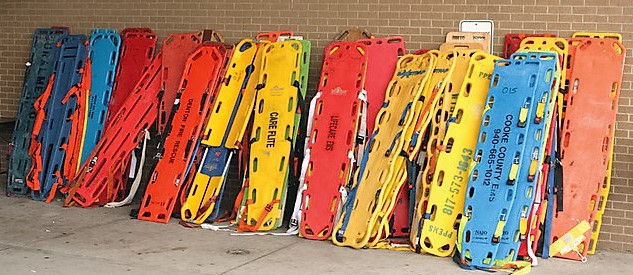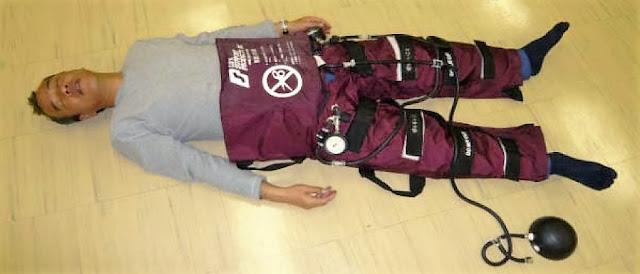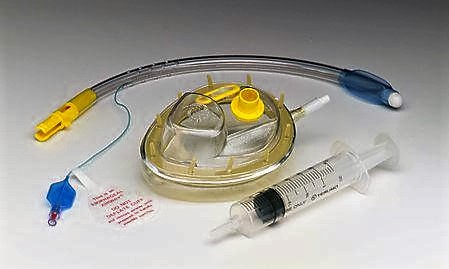 |
| prehospital spinal immobilization on backboards |
10 obsolete EMT skills
Gather round to learn the out-of-date and obsolete EMT skills that the Ambulance Driver has outlasted during his EMS career
Jun 29, 2016
Nothing makes me feel older than when I drop a casual reference to an EMT skill in a continuing education class and several bewildered young EMTs raise their hands hesitantly and ask, "Kelly, what are MAST pants?"
It got me to thinking how different the EMS profession is now from what it was when my career began. Medicine is a continually evolving process, and advances in technology come so rapidly that the current generation of EMS providers is working with a markedly different knowledge base and set of skills than the last one.
So gather around the campfire children and let Uncle Kelly tell you how we did it in the old days. Each of these 10 skills is something we used to commonly do, but are rarely, if ever, used any longer.
 |
| Pneumatic Anti-Shock Garments |
10. Pneumatic Anti-Shock Garments
I only spell it out because if I said MAST or PASG, I’d still have to explain it to you young whippersnappers. See, back in the day we used to put these inflatable Velcro pants on shock patients, and when inflated, it raised their blood pressure. It did raise blood pressure very well — to the point that the patient bled pink from all the IV fluids we gave, but those magic pants sucked at saving lives.
I only spell it out because if I said MAST or PASG, I’d still have to explain it to you young whippersnappers. See, back in the day we used to put these inflatable Velcro pants on shock patients, and when inflated, it raised their blood pressure. It did raise blood pressure very well — to the point that the patient bled pink from all the IV fluids we gave, but those magic pants sucked at saving lives.
Not only did we have to know the different methods of applying them, like the diaper method and the pajama method, we also had to memorize the criteria for removal. Dinosaurs, say them with me now: “Bilateral large bore IV access, two units of typed and matched blood, surgical team on standby, deflate the abdominal section for 10 seconds, recheck the blood pressure …”
MAST Pantalon Anti-Shock. Military anti-shock trousers, or pneumatic anti-shock garments (PASG)
https://emssolutionsint.blogspot.com/2019/04/mast-pantalon-anti-shock-military-anti.html
 |
| Manual defibrillation paddles |
9. Manual defibrillation paddles
You kids these days with your hippity-hop music and your iThings and your hands-free multifunction electrodes.… Why, in my day, when we wanted to defibrillate someone, we had these things called paddles. And you had to apply conductive gel to them and smear it around; then you had to press them on the chest with at least 25 pounds of paddle pressure
You kids these days with your hippity-hop music and your iThings and your hands-free multifunction electrodes.… Why, in my day, when we wanted to defibrillate someone, we had these things called paddles. And you had to apply conductive gel to them and smear it around; then you had to press them on the chest with at least 25 pounds of paddle pressure
And you had your energy select dial and defib button right there on the paddles. And you did this thing called a quick look, so that you could immediately shock the patient, like, three times in a row, before you even attached the monitor leads.
And by God, we were grateful.
 |
| Esophageal Obturator Airways |
8. Esophageal Obturator Airways
Imagine if a Combitube and a BVM had a baby, and the airway baby inherited the worst features of each. The EOA was a supraglottic airway that was bulky, often caused trauma on insertion, did a poor job of isolating the trachea and protecting against aspiration and still required that you maintain a mask seal.
Imagine if a Combitube and a BVM had a baby, and the airway baby inherited the worst features of each. The EOA was a supraglottic airway that was bulky, often caused trauma on insertion, did a poor job of isolating the trachea and protecting against aspiration and still required that you maintain a mask seal.
And to think that nobody uses these beauties anymore! Crazy, right?
 |
| Oral screws |
7. Oral screws
Picture — because I am afraid of what you might stumble across if you Google "oral screws" — if you will a little plastic doohickey shaped like a miniature ice cream cone with threads on the outer surface and a T-handle on the large end. And what you did was insert the small end of this doohickey between someone’s teeth when their jaws were clenched, and screwed it in until it forced their jaws apart.
Picture — because I am afraid of what you might stumble across if you Google "oral screws" — if you will a little plastic doohickey shaped like a miniature ice cream cone with threads on the outer surface and a T-handle on the large end. And what you did was insert the small end of this doohickey between someone’s teeth when their jaws were clenched, and screwed it in until it forced their jaws apart.
We used to do this whenever someone had a seizure, in the mistaken belief that if we didn’t get their mouth open, they’d swallow their tongue.
But the real reason was that it gave paramedics with a juvenile sense of humor the opportunity to hold out their hands and bark, "Gimme an oral screw!"
I’m telling you, that one never got old.
6. Taping stuff down
When I was a paramedic student, my instructor took great pains to show us how to tear thin little strips of adhesive tape to secure IV catheters and endotracheal tubes. We fashioned elegant little chevrons of tape over the wings on our IV catheter hubs (seriously, they had wings) to secure them without obscuring the cannulation site. And we used to tear a one-inch strip of tape longitudinally for a few inches, wrapping one strip around the endotracheal tube and the other across the face like a big mustache.
When I was a paramedic student, my instructor took great pains to show us how to tear thin little strips of adhesive tape to secure IV catheters and endotracheal tubes. We fashioned elegant little chevrons of tape over the wings on our IV catheter hubs (seriously, they had wings) to secure them without obscuring the cannulation site. And we used to tear a one-inch strip of tape longitudinally for a few inches, wrapping one strip around the endotracheal tube and the other across the face like a big mustache.
And then someone would promptly rip our IV or endotracheal tube out while we were loading the patient, so we got to do it again.
Nowadays we have tube holders and IV dressings, and taping is a lost art like calligraphy and darning your socks.
5. Rotating tourniquets
Once upon a time, we used to think that acute pulmonary edema and decompensated congestive heart failure was caused by too much blood re-entering the lungs. We thought that if we could trap blood in the extremities, we’d reduce preload enough to relieve the pulmonary edema.
Once upon a time, we used to think that acute pulmonary edema and decompensated congestive heart failure was caused by too much blood re-entering the lungs. We thought that if we could trap blood in the extremities, we’d reduce preload enough to relieve the pulmonary edema.
So we applied humongous blood pressure cuffs on three of the patient's four extremities, inflated them to just above diastolic pressure, and rotated them around the patient's extremities every 15 minutes.
And it took us only a generation or so to discover that it was stupid and didn’t work.
 |
| Trendelenburg position |
4. Trendelenburg position
For many years we fervently believed the Trendelenburg position was a vital treatment for shock. We thought that elevating the feet higher than the head raised blood pressure, and maybe even caused a couple units of blood to flow from the legs to the trunk.
For many years we fervently believed the Trendelenburg position was a vital treatment for shock. We thought that elevating the feet higher than the head raised blood pressure, and maybe even caused a couple units of blood to flow from the legs to the trunk.
Turns out it doesn’t really do those things, and instead caused respiratory decompensation and a rise in intracranial pressure. Still, that doesn’t keep some EMTs working for the EMS Agency That Time Forgot from carefully applying and documenting "patient placed in Trendelenburg position."
3. Standing takedowns
Now that our current understanding of spinal cord injury acknowledges that prehospital spinal immobilization on backboards has virtually no supporting evidence and probably does more harm than good, we’re boarding far fewer people these days.
Now that our current understanding of spinal cord injury acknowledges that prehospital spinal immobilization on backboards has virtually no supporting evidence and probably does more harm than good, we’re boarding far fewer people these days.
While the adage holds true that “absence of evidence does not mean evidence of absence,” and there may be some yet-undiscovered tiny subset of patients that benefit from strapping a curved body to a flat board, it’s a pretty safe bet that subset does not include people walking around the scene under their own power.
 |
| External jugular IV access |
2. External jugular IV access
Honestly, I really miss this one. The EJ used to be my go-to vein in a code. I was already right there at the head intubating, and all it took was turning the patient’s head to one side a bit, sinking a 14-gauge in that fat, engorged vein, and you had the mother of all peripheral IV accesses.
Honestly, I really miss this one. The EJ used to be my go-to vein in a code. I was already right there at the head intubating, and all it took was turning the patient’s head to one side a bit, sinking a 14-gauge in that fat, engorged vein, and you had the mother of all peripheral IV accesses.
You know, we did this so all those questionably beneficial drugs we gave could reach the heart that much faster. Now, with mechanical IO devices like the EZ-IO in my repertoire, I can’t remember the last time I started an EJ.
Adult IO devices have really revolutionized emergency peripheral vascular access. And not a moment too soon, either, before this intracavernous technique really caught on.
1. Radio 10 codes
Once upon a time, we used to take sadistic pleasure in rapid fire broadcasting to the brand-new dispatcher, "Dispatch, we’re 10-98, 10-8, 10-19, 10-18 to our 10-42, where we’ll be 10-7 for a few minutes for a 10-33 10-100. If we’re not 10-2 on that, we’ll be happy to 10-9."
Once upon a time, we used to take sadistic pleasure in rapid fire broadcasting to the brand-new dispatcher, "Dispatch, we’re 10-98, 10-8, 10-19, 10-18 to our 10-42, where we’ll be 10-7 for a few minutes for a 10-33 10-100. If we’re not 10-2 on that, we’ll be happy to 10-9."
Now that we communicate in plain English because 10 codes are confusing and vary between agencies, we get to say, "Dispatch, we’ve completed our last assignment and are available for call, but we’re heading to our station as soon as possible because my partner will be out of service taking an emergency all-he-could-eat taco buffet poop. If you didn’t copy all that, I’m willing to repeat it."
Or at least we get to say that once.
I could think of a few more EMT skills that may soon become obsolete if we don’t get better at applying them, but that’s my list of top 10 obsolete EMT skills.
Got any to add to the list? Chime in with yours in the comments.

